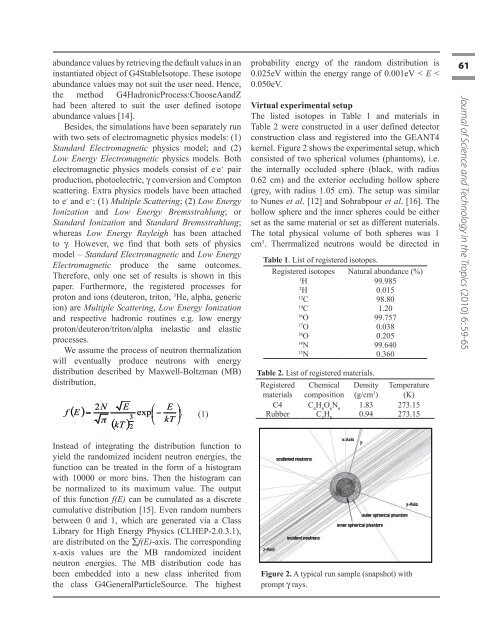Download - Akademi Sains Malaysia
Download - Akademi Sains Malaysia
Download - Akademi Sains Malaysia
Create successful ePaper yourself
Turn your PDF publications into a flip-book with our unique Google optimized e-Paper software.
abundance values by retrieving the default values in an<br />
instantiated object of G4StableIsotope. These isotope<br />
abundance values may not suit the user need. Hence,<br />
the method G4HadronicProcess:ChooseAandZ<br />
had been altered to suit the user defined isotope<br />
abundance values [14].<br />
Besides, the simulations have been separately run<br />
with two sets of electromagnetic physics models: (1)<br />
Standard Electromagnetic physics model; and (2)<br />
Low Energy Electromagnetic physics models. Both<br />
electromagnetic physics models consist of e - e + pair<br />
production, photoelectric, γ conversion and Compton<br />
scattering. Extra physics models have been attached<br />
to e - and e + : (1) Multiple Scattering; (2) Low Energy<br />
Ionization and Low Energy Bremsstrahlung; or<br />
Standard Ionization and Standard Bremsstrahlung;<br />
whereas Low Energy Rayleigh has been attached<br />
to γ. However, we find that both sets of physics<br />
model – Standard Electromagnetic and Low Energy<br />
Electromagnetic produce the same outcomes.<br />
Therefore, only one set of results is shown in this<br />
paper. Furthermore, the registered processes for<br />
proton and ions (deuteron, triton, 3 He, alpha, generic<br />
ion) are Multiple Scattering, Low Energy Ionization<br />
and respective hadronic routines e.g. low energy<br />
proton/deuteron/triton/alpha inelastic and elastic<br />
processes.<br />
We assume the process of neutron thermalization<br />
will eventually produce neutrons with energy<br />
distribution described by Maxwell-Boltzman (MB)<br />
distribution,<br />
(1)<br />
Instead of integrating the distribution function to<br />
yield the randomized incident neutron energies, the<br />
function can be treated in the form of a histogram<br />
with 10000 or more bins. Then the histogram can<br />
be normalized to its maximum value. The output<br />
of this function f(E) can be cumulated as a discrete<br />
cumulative distribution [15]. Even random numbers<br />
between 0 and 1, which are generated via a Class<br />
Library for High Energy Physics (CLHEP-2.0.3.1),<br />
are distributed on the ∑f(E)-axis. The corresponding<br />
x-axis values are the MB randomized incident<br />
neutron energies. The MB distribution code has<br />
been embedded into a new class inherited from<br />
the class G4GeneralParticleSource. The highest<br />
<br />
probability energy of the random distribution is<br />
0.025eV within the energy range of 0.001eV < E <<br />
0.050eV.<br />
Virtual experimental setup<br />
The listed isotopes in Table 1 and materials in<br />
Table 2 were constructed in a user defined detector<br />
construction class and registered into the GEANT4<br />
kernel. Figure 2 shows the experimental setup, which<br />
consisted of two spherical volumes (phantoms), i.e.<br />
the internally occluded sphere (black, with radius<br />
0.62 cm) and the exterior occluding hollow sphere<br />
(grey, with radius 1.05 cm). The setup was similar<br />
to Nunes et al. [12] and Sohrabpour et al. [16]. The<br />
hollow sphere and the inner spheres could be either<br />
set as the same material or set as different materials.<br />
The total physical volume of both spheres was 1<br />
cm 3 . Therrmalized neutrons would be directed in<br />
Table 1. List of registered isotopes.<br />
Registered isotopes Natural abundance (%)<br />
1 H 99.985<br />
2 H 0.015<br />
12 C 98.80<br />
14 C 1.20<br />
16 O 99.757<br />
17 O 0.038<br />
18 O 0.205<br />
14 N 99.640<br />
15 N 0.360<br />
Table 2. List of registered materials.<br />
Registered Chemical Density<br />
materials composition (g/cm3 Temperature<br />
) (K)<br />
C4<br />
Rubber<br />
C H O N 4 6 6 6<br />
C H 5 8<br />
1.83<br />
0.94<br />
273.15<br />
273.15<br />
Figure 2. A typical run sample (snapshot) with<br />
prompt γ rays.<br />
Jostt vol 6.indd 61 7/22/10 10:09:55 PM<br />
<br />
61<br />
Journal of Science and Technology in the Tropics (2010) 6: 59-65

















